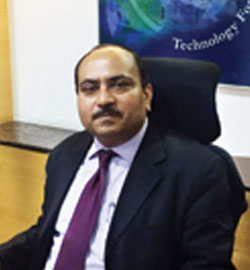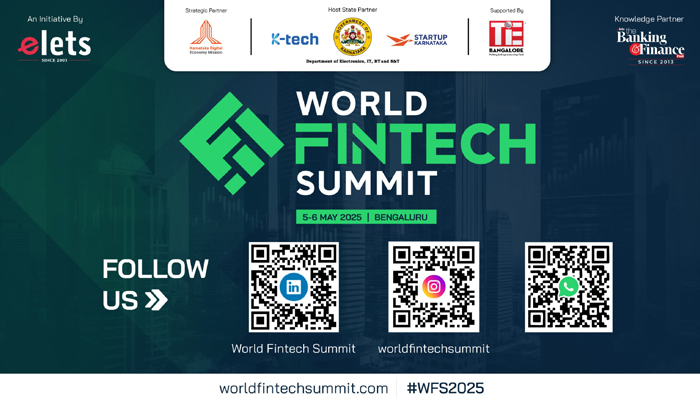
Chief Technology Officer (CTO), SBI
India’s largest lender – State Bank of India (SBI) – has implemented comprehensive trade finance solutions in five countries out of 26, where it has business operations, and also signed a contract with Encore Theme to offer front-to-back trade finance solutions across these countries, says Shiv Kumar Bhasin, Chief Technology Officer (CTO), SBI, in an interview with Arpit Gupta of Elets News Network (ENN)
The State Bank of India has signed a contract with Encore Theme to implement comprehensive front-toback office trade solution in several countries. How will it help corporate customers in their cross-border trade business?
 As CTO, I handle the Technology wing in the State Bank of India, whose job is to stay focused and work on innovations like digitisation, re-engineering and transformation areas. Under these heads, we are carrying out various programmes, which lead to transformation of the Core Banking System (CBS), going into the various new digital channels – be it a wearable devices banking, social media banking, the wallets or newer technologies. These are the staple menu options for any bank. We are using lots of innovative frameworks, most of which are the market leaders. A lot of transformation has also been brought about in the product platform, like in the foreign office, we have migrated from our old version of core banking platform to the latest version last year in record time. Simultaneously, we also started the trade finance platform. For trade finance platform, sufficient functionality was not available in the existing platform.
As CTO, I handle the Technology wing in the State Bank of India, whose job is to stay focused and work on innovations like digitisation, re-engineering and transformation areas. Under these heads, we are carrying out various programmes, which lead to transformation of the Core Banking System (CBS), going into the various new digital channels – be it a wearable devices banking, social media banking, the wallets or newer technologies. These are the staple menu options for any bank. We are using lots of innovative frameworks, most of which are the market leaders. A lot of transformation has also been brought about in the product platform, like in the foreign office, we have migrated from our old version of core banking platform to the latest version last year in record time. Simultaneously, we also started the trade finance platform. For trade finance platform, sufficient functionality was not available in the existing platform.
SBI has two business units – National Banking Group (NBG) and International Banking Group (IBG). Last year, former MD IBG Krishna Kumar decided to go for the trade finance platform, and around 25 per cent of the revenue of the bank should be coming in the next five years through international banking. The percentage currently is much lower, but it has witnessed improvement in comparison to the last year. Keeping in mind the revenue growth, we wanted a diversified platform, which can host many international products suiting to the global market places as well as cater to the trade corridors across the globe. This way, some of our Indian customers having businesses abroad and those in India could be served.
There are trade corridors between the US and India, the UK and India, Middle East and India or India and Africa, etc., and operating in these trade corridors have been traditional NRI corporate. Keeping these things in mind, we wanted that whatever trade products we launch have same customer experience across the globe. So, we needed a single unified platform which can handle a multi-entity environment, and that is what Misys Trade Finance Platform and trade portal was offering us. Hence we selected it. So far, we have released it for the five countries and we have business across 26 countries, and plan to launch trade finance platform in all these countries. We are looking further to the next level of technology on the lines of international corporate portals working on a single sign on model. By January 2017, we shall be able to finish implementation. Before the close of 2016-17 financial year, we will have all 26 countries live with Trade Finance and Misys Trade Portal.
What is the roadmap of SBI to achieve its ambitious goal to become one of the leading global banks from India?
We have business offices right from Japan to the US West Coast, so the entire time zones are being served by our international banking group. One of the differentiating points of the Encore Theme and Misys products have been that they support multi-entity implementation, and Encore Theme, based on their experience in the international market in the Middle East and some of the Far East countries, they have dealt with the diversity of the time zones. We had requirement similar to this, as we have business offices in Japan, Hong Kong, Australia, Singapore, Indian Ocean countries, the Middle East and West Coast. We have divided the world in five time zones and we have grouped the countries accordingly.
Also, we are fully automating the end-of-day processes so that there is no human intervention in spite of various time zones being there. That’s where Encore Theme will help us out to automate the process and get us all the information at the click of a button.
We are using lots of innovative frameworks, most of which are the market leaders. In our foreign office, we have migrated from core banking platform to the latest version last year
What challenges do you see in offering a worldclass experience to the customers with changing needs?
When we look at offering the world class services, the key challenge is that our domestic processes are still paper-based, while in the international banking, the drive is to go for digital, i.e. paperless. That’s where we are bringing this multi-entity deployment of Misys platform, so that we can have our back office trade operations in all 26 countries consolidated in India. Currently, all trade finance operations are in the specific countries. But very soon, we will have a very small footprint or very small shop in foreign country, with a Centralised Processing Centre doing the complete back office operations in India. India being a cheaper location, many western banks are setting up their operation centre, while we still continue to hold our operation centre in those native countries.
So that we can provide a uniform customer experience while processing any trade LCs and BG’s or different trade finance products. Whatever the regulatory requirements allow us to make it paperless wherever signatures are not required we will be going lot of digitisation. We will be asking the customers to book their LC & BG’s thru the Misys Trade Portal which will be given to them, so they don’t need to visit branches. Any paper documents need to be flowing from those countries they will be flowing in the form of scan document over the workflo defined. Having a same product across all these countries deployed in a multi-entity fashion was much needed. The first step we did during this roll out that we unified the business process largely across the country thru Model Bank implementation approach. So if the business processes are aligned, remaining things will start falling in place. So unless there are specific regulatory requirements in some countries, largely the trade finance process have been unified and same processes are executed across the countries. First step was to unify the process and second step was consolidation of business operations at the central location to give the global experience and similar experience across multiple global branches of SBI. These are two key things we did to offer world class customer experience.
Technology adoption in banks…used to be a huge challenge few years back, but now Indian PSU banks have learnt that if they have to survive in this competitive market, they have to embrace technology
 How important has leveraging technology and innovation become in the changing banking scenario? Can you highlight adoption and infrastructure challenges for the banks?
How important has leveraging technology and innovation become in the changing banking scenario? Can you highlight adoption and infrastructure challenges for the banks?
Technology adoption in banks is significantly high. It used to be a huge challenge few years back, but now Indian PSU banks have learnt that if they have to survive in this competitive market, they have to embrace technology, also because it helps cuts the overall operation costs. The cost to income ratio can be brought down below 40 per cent using technology. We have a clear message from the SBI Chairperson that the cost to income ratio over a period of three years should be coming down below 40 per cent, which is a global benchmark. Most profitable banks are running the cost to income ratio around 40 per cent or below. That’s where we have a lot of drive to adopt digital technology.
Give us a brief about the concept of Digital Financial Superstore.
We are in the process of setting up a Digital Financial Superstore where all the corporate banking products would be hosted and the customer acquisition can happen online and the corporate banking products could be bought from the superstore. That will be a very big game changer for the industry. It is not just the front-end but back-end process will also be paperless, aligned with that product and customer acquisition could be straight through process.
What role small FinTech companies have to play in the banking sector?
FinTech companies have major role to play to bring innovation in the Trade Finance, Bill Discounting and SME/Corporate Loans processes. One of the core differences in approach to financial services between banks and FinTech lies in democratization. FinTech companies often aim to serve a noble goal of financial inclusion and making financial services more accessible for those not fitting into the credit score-based estimation of eligibility for another loan. SBI is collaborating with FinTech companies to enhance customer experience & service. SBI is fueling innovation by partnering with FinTechs using its Core Banking Services published as APIs to integrate with FinTech products & services. FinTech companies need to focus on the pain points of Corporate Banking & Trade Finance processes to bring more innovations
Elets The Banking and Finance Post Magazine has carved out a niche for itself in the crowded market with exclusive & unique content. Get in-depth insights on trend-setting innovations & transformation in the BFSI sector. Best offers for Print + Digital issues! Subscribe here➔ www.eletsonline.com/subscription/




















